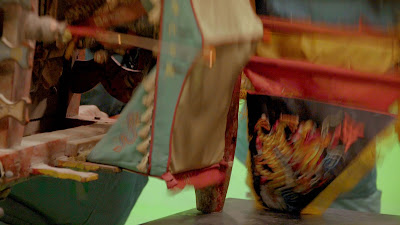神靈的書寫 Spirit-writing
雙頻道錄像裝置 two-channel video installation,9'45",2016製片 Produce by: Le Fresnoy
聯合製片 Co-producer:尊彩藝術中心 Liang Gallery
Video installation Spirit-writing presents an unusual dialogue between artist Chia-Wei Hsu and the frog god Marshal Tie Jia who allegedly was born in a small pond more than 1,400 years ago in Jiangxi, China. It is said that his temple in the Wuyi Mountains was destroyed during the Cultural Revolution, so he has since been taking shelter on Matsu Island. The local villagers communicate with Marshal Tie Jia through a unique divination chair ritual. The divination chair shakes violently under divine orders and proceeds to hit the altar table and write down commands decreed by the divine power during the ritual. Sometimes, legible words are written down, but there are also times when the writing needs to be deciphered through further gestures of pounding or making noises. The villagers use this ritual to help them make decisions on many things in life.
Marshal Tie-Jia was invited by Chia-Wei Hsu to come to a film studio, where the divination chair ritual was performed to ask the frog god about the original conditions of his temple in the Wuyi Mountains. Hsu also reported to the Marshal about the approach and concept behind this art project. The process was made into a documentary, with an animation presented at the same time. Motion capture technology was applied in the film studio to document the movements of the divination char, which was post-produced into a 3D animation. A 3D temple is also constructed according to the fragmented clues provided by Marshal Tia-Jia.
This two-channel video installation showcases the dialogue between the artist and the frog god, integrating contemporary art and folk belief, the digital world and the realm of the divine.
《神靈的書寫》錄像裝置呈現藝術家許家維與青蛙神鐵甲元帥之間的一段不尋常對話的過程。鐵甲元帥據說是在一千四百年以前,出生於中國江西省的小池塘。祂原本駐紮在中國武夷山上的寺廟,文化大革命毀了那座廟以後,馬祖成了祂的避難之地。馬祖村民以一種很特殊的扛乩儀式與鐵甲元帥溝通,在儀式的過程中,神轎會在神明的驅使下劇烈晃動,撞擊神桌並寫下神明的指示。有時元帥會寫下清晰可辨的文字,有時則必須依撞擊的動作或是聲響來判斷,村民生活中的許多事情都透過這個儀式來決定。
許家維邀請鐵甲元帥進入攝影棚,透過扛乩儀式向祂詢問有關武夷山上那座廟宇的原初樣貌,同時也向祂解釋這個藝術計畫的執行方式與概念。他將這個過程拍攝成一部紀錄片,而與紀錄片對稱展出的是一部動畫片,內容源自於攝影棚中針對神轎所進行的動態捕捉(motion capture),透過此技術,將神轎的動態轉化為3D動畫,並且依據元帥所描述的片斷線索,建構一個3D的廟宇場景。
這個雙頻道錄像裝置所呈現的是藝術家與神明、當代藝術與民俗信仰,以及數位世界與神性世界的對話過程。










沒有留言:
發佈留言